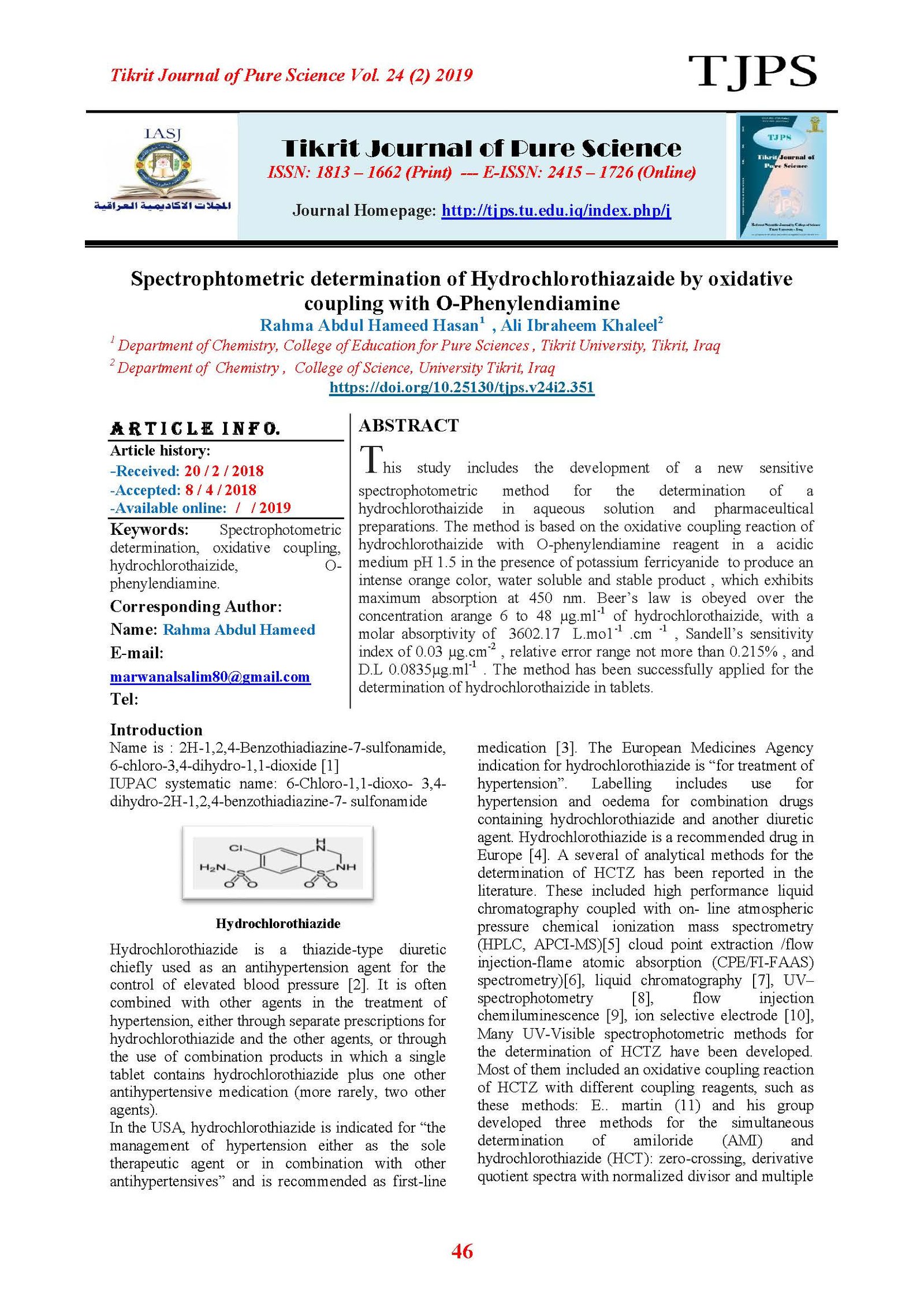Spectrophtometric determination of Hydrochlorothiazaide by oxidative coupling with O-Phenylendiamine
Main Article Content
Abstract
This study includes the development of a new sensitive spectrophotometric method for the determination of a hydrochlorothaizide in aqueous solution and pharmaceultical preparations. The method is based on the oxidative coupling reaction of hydrochlorothaizide with O-phenylendiamine reagent in a acidic medium pH 1.5 in the presence of potassium ferricyanide to produce an intense orange color, water soluble and stable product , which exhibits maximum absorption at 450 nm. Beer’s law is obeyed over the concentration arange 6 to 48 µg.ml-1 of hydrochlorothaizide, with a molar absorptivity of 3602.17 L.mo1-1 .cm -1 , Sandell’s sensitivity index of 0.03 µg.cm-2 , relative error range not more than 0.215% , and D.L 0.0835µg.ml-1 . The method has been successfully applied for the determination of hydrochlorothaizide in tablets.
Article Details

This work is licensed under a Creative Commons Attribution 4.0 International License.
Tikrit Journal of Pure Science is licensed under the Creative Commons Attribution 4.0 International License, which allows users to copy, create extracts, abstracts, and new works from the article, alter and revise the article, and make commercial use of the article (including reuse and/or resale of the article by commercial entities), provided the user gives appropriate credit (with a link to the formal publication through the relevant DOI), provides a link to the license, indicates if changes were made, and the licensor is not represented as endorsing the use made of the work. The authors hold the copyright for their published work on the Tikrit J. Pure Sci. website, while Tikrit J. Pure Sci. is responsible for appreciate citation of their work, which is released under CC-BY-4.0, enabling the unrestricted use, distribution, and reproduction of an article in any medium, provided that the original work is properly cited.
References
[1] SciFinder Databases: Registry, Chemcats. American Chemical Society. Available from: http://www.cas.org/products/scifinder,(2013).
[2] Neil, O.M.J. (2001). The Merck Index- An Encyclopedia of Chemicals, Drugs, and Biologicals, 13th edn. Whitehouse Station (NJ): Merck & Co., Inc.
[3] Chobanian, AV. et al. (2003). Joint National Committee on Prevention, Detection, Evaluation, and Treatment of High Blood Pressure. National Heart, Lung, and Blood Institute; National High Blood Pressure Education Program Coordinating Committee (2003). Seventh report of the Joint National Committee on Prevention, Detection, Evaluation, and Treatment of High Blood Pressure. Hypertension, 42(6): 1206–52.
[4] Mansia, G. et al. (2009). European Society of Hypertension. Reappraisal of European guidelines on hypertension management: a European Society of Hypertension Task Force document. Journal Hypertens, 27(11): 2121–58.
[5] Combs, M.T.; Ashraf-Khorassani, M. and Taylor L.T. (1999). Journal Pharm. Biomed Anal., (19): 301-308.
[6] Dadfarnia, S.; Hajishabani, A. and Rad, H.F. (2011). Journal Chin. Chem. Soci., (58): 503-508.
[7] Valentina, G. et al. (2009). Anal. Chim. Acta, (1): 18-23.
[8] Kothacota, V. et al. (2011). Intern. Journal Pharm. Biolog., 2(4): 1167-1171.
[9] Jing, F.; Yahong, C.; Suling, F.; Cunling, Y. and Jianji, W. (2003). Anal. Sci., (19): 419-422.
[10] Ayman, H.K.; Sofia, A.A.; Goreti, M.F.S. and Felismina, T.C.M. (2009). Anal. Sci., (25): 365- 371.
[11] Martín, E.; Hernández, O.; Jiménez, F. and Arias, J.J. (2006). Simultaneous Spectrophotometric Determination of Hydrochlorothiazide and Pharmaceutical Preparations: 1449-1464.
[12] Sane, R.T. and Narkar, V.S. (2002). Indian Drugs, 18(23).
